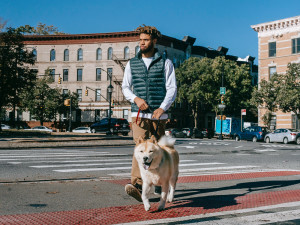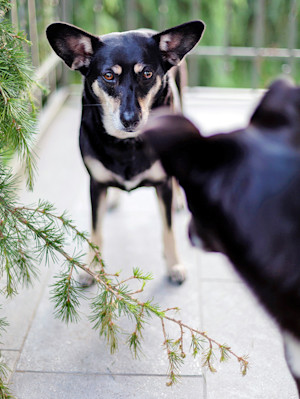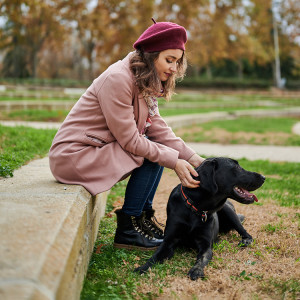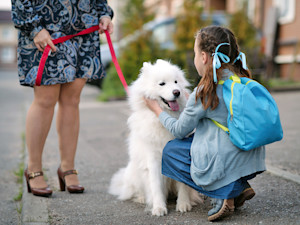How to Manage Leash Reactivity in Your Dog
If your pup acts diabolical on walks, you are not alone. Here’s what you can do.

Share Article
As much as you love your leash-reactive dog, they can make walks challenging, to say the least. When they throw a fit because they see another dog, a person, or a leaf that blows their way, it can be downright mortifying. Other dog parents stare while their own pup walks serenely past your own, as if silently judging you. Before you head out on a walk with your leash-volatile pup, you probably find yourself singing some version of Sabrina Carpenter’s “Please, Please, Please.” (“Heartbreak is one thing, my ego’s another. I beg you, don’t embarrass me...”)
Unfortunately, there is no magic way to get them to stop this behavior. Effectively managing leash reactivity requires patience and diligence. Leash reactivity involves dogs lunging, barking, or otherwise responding explosively to passing people, animals, or stimuli while restrained on walks.
Tackle leash reactivity with these steps:
Step one: Create positive associations.
Begin counterconditioning your pup’s behavior using high-value treats that you only give them during outings to shift associations with triggers from scary to pleasant. Reward disengagement.

Step two: Change it up.
Choose alternate walking routes and times to avoid likely triggers for quick wins while rigorously training emotional control around milder stimuli. Avoid aggravating triggers, which can delay their progress.
Step three: Purchase a better leash.
Invest in adaptable transitional leashes that enable you to adjust control while preventing lunging and nibbling. Never drag or choke your dog with their leash, which only exacerbates bad behaviors and creates negative associations.
Step four: Refocus your dog’s attention.
Interrupt fixating triggers by changing direction, blocking sight lines, or creating distractions, like squeaking a toy. Refocus their attention positively on you rather than allowing them to fixate on stimuli.
Step five: Stay calm.
Model relaxed, tension-free body language. Soothing praise for appropriate check-ins reinforces focusing on you over their environment. Remember, excitable or tense human energy often makes dogs more reactive.
Step six: Assess your dog’s triggers.
Consider why your dog may dislike restraints — feeling vulnerable, lacking environmental awareness, or associating proximity to you with other “threats,” like other people walking their dogs, could all contribute. Identify and resolve root causes when feasible.
What is leash reactivity?
Leash reactivity is when your dog overreacts to a stimulus while they are on a leash. Dogs can be “reactive” toward any kind of trigger they have a negative association with, such as other dogs, cars, or people. As mentioned above, reactivity could look like lunging, barking, or growling. Some dogs may be fearful or try to run away from the thing that upsets them.
Where does this reactive behavior come from? To understand reactivity, it’s first necessary to understand how a dog communicates (hint: it’s a lot different than how humans communicate). Dogs prefer to give each other space, circle around each other, sniff butts, and then maybe play or, if they decide they don’t like each other, get out of each other’s faces.
And what happens when you introduce a leash into the mix? Well, a leash essentially puts a dog in a “cage” — their movements are restricted, largely out of their control. On-leash greetings often occur head-on and face-to-face, which is not a typical way for dogs to greet each other naturally. There are several reasons why a dog may not like this type of greeting:
It makes them feel protective.
Some dogs get very sensitive or upset when a stranger (human or canine) comes close to their beloved pet parent.
It frustrates them.
Some dogs get really excited by the prospect of saying hey to another dog — but alas — the leash! It gets in the way, and then they get frustrated.
It makes them feel scared.
If a dog is fearful of the stimuli in front of them, the leash interrupts their biological “flight” response, and doesn’t fully allow them to escape from the thing that’s upsetting them — which can cause even more stress.
How to train a leash-reactive dog:
The goal of leash-reactivity training is to keep the dog below their threshold of frustration. This way, they can see the thing causing the reactivity without getting upset. You have to change their reaction to the stimuli, but you can only do that if you start their training at a safe distance away from the trigger.
If their reactivity is severe and prevents you or your dog from feeling comfortable on a walk, it is best to enlist the help of a trainer ASAP. While training, whether on your own or with a trainer, you want to work up to distances that are closer to the stimuli. Reward them with a treat often, especially as you near the problem.
Eventually, your pup should exhibit fewer stress signals as they near their trigger. An important note: Don’t rush. Each dog will go at their own pace. If you see your dog exhibiting signs of stress or frustration, then you’ve moved too quickly and are expecting more from them than they can handle. Back off, and try again at a farther distance. Keep up your training routine as long as you need until their previous trigger is no longer bothering them.
P.S. Never use a retractable leashopens in new tab. They offer zero control and often jam, putting your pet (and any others within 20 feet) at risk.
Mari Shelafoe
Mari Shelafoe is a writer.
Related articles
![Man walking his dog in the city]()
The B.A.T. Dog Training Method Is What’s Up
Behavior Adjustment Training (B.A.T.) will keep your dog calm in any situation. For real.
![Two dogs staring at each other outside.]()
How to Interpret and Stop Aggression in Dogs
Learn what causes this behavior and how you can help your pup.
Top 7 Reasons Why Dogs Growl When You Pet Them
It’s OK—they don’t suddenly hate you.
![Woman wearing a magenta beret hat and a pink coat sitting on a wall outside and petting her black Labrador dog laying on the ground]()
How to Interpret Your Dog’s Facial Expressions and Behavior
Managing expectations about your dog’s behavior makes for a good relationship
![Little schoolgirl happy to see her dog before or after school.]()
School’s Back in Session—How to Deal if Your Dog Gets Overwhelmed by the Chaos
Noisy school buses and crowds of roving children can be scary for some pups.





